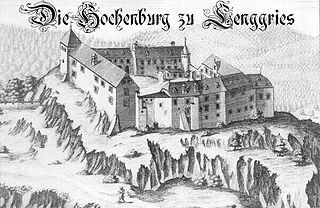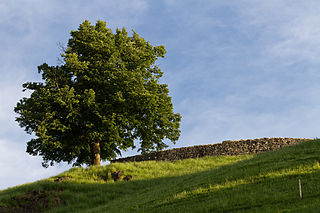
The Old Swiss Confederacy began as a late medieval alliance between the communities of the valleys in the Central Alps, at the time part of the Holy Roman Empire, to facilitate the management of common interests such as free trade and to ensure the peace along the important trade routes through the mountains. The Hohenstaufen emperors had granted these valleys reichsfrei status in the early 13th century. As reichsfrei regions, the cantons of Uri, Schwyz, and Unterwalden were under the direct authority of the emperor without any intermediate liege lords and thus were largely autonomous.

Silenen is a municipality in the canton of Uri in Switzerland.

The Castelli di Cannero are three rocky islets of Lake Maggiore in northern Italy. They are located off the shoreline of Cannero Riviera while administratively forming part of the Comune of Cannobio. They are known as castelli, or castles, in recognition of the ruined ancient fortifications which are found on two of them. They are all that remains of the Rocca Vitaliana fortress built between 1519 and 1521 by Ludovico Borromeo, who gave it this name in honour of an illustrious ancestor.

The Castles of Bellinzona are a group of fortifications located around the town of Bellinzona, the capital of the Swiss canton of Ticino. Situated on the Alpine foothills, the group is composed of fortified walls and three castles named Castelgrande, Montebello and Sasso Corbaro. Castelgrande is located on a rocky peak overlooking the valley, with a series of walls that protect the old city and connect to Montebello. Sasso Corbaro, the highest of the three castles, is located on an isolated rocky promontory south-east of the other two. The Castles of Bellinzona with their defensive walls have been an UNESCO World Heritage Site since 2000.

Crèvecœur Castle is a ruined castle in Belgium. The ruins of the Château de Crèvecœur are located in Bouvignes-sur-Meuse, part of the Belgian city of Dinant, province of Namur, Wallonia. The castle is owned by the Walloon Region. The ruin field can be visited freely all year.

Marmels Castle German: Burg Marmels is a ruined castle in the municipality of Marmorera in the district of Albula in the canton of Graubünden in Switzerland.

The siege of Godesberg, 18 November – 17 December 1583, was the first major siege of the Cologne War (1583–1589). Seeking to wrest control of an important fortification, Bavarian and mercenary soldiers surrounded the Godesberg, and the village then of the same name, now Bad Godesberg, located at its foot. On top of the mountain sat a formidable fortress, similarly named Godesburg, built in the early 13th century during a contest over the election of two competing archbishops.

Frohberg Castle is a medieval castle ruin in the Swiss municipality of Aesch in the canton of canton of Basel-Land.

Attinghausen Castle is a ruined medieval castle in the municipality of Attinghausen in the canton of Uri in Switzerland. It is a Swiss heritage site of national significance.

Meierturm is a medieval tower in the municipality of Silenen in the canton of Uri in Switzerland. It is a Swiss heritage site of national significance.
Seedorf Castle is a medieval castle ruin in the municipality of Seedorf in the canton of Uri in Switzerland. It is near the school complex of Seedorf and across the street from the newer castle of Apro.

Fracstein Castle is a castle in the municipality of Seewis im Prättigau of the Canton of Graubünden in Switzerland. It is a Swiss heritage site of national significance.

Dough Castle is a ruined tower house at Lahinch in County Clare, western Ireland. It was established by the O'Conors in the early 14th century, but nothing remains of the original structures.

The Hohenburg is a ruined medieval castle near Lenggries in Bavaria, Germany. Once a dominating centre of power in the region, it was destroyed by fire on 21 July 1717.

Schaaken Castle is a ruined castle originally built for the Teutonic Knights, in Nekrasovo, Kaliningrad Oblast, Russia. It was extensively altered in the 19th century and has become a ruin since World War II.

Bernau Castle is a ruined castle in the municipality of Leibstadt in the canton of Aargau in Switzerland. It was mostly destroyed in a fire in July 1844 leaving only a few ruined walls still visible.

Neideck Castle is a former high mediaeval nobleman's castle above the village of Streitberg, in the municipality of Wiesenttal in the Upper Franconian county of Forchheim in the German state of Bavaria. As a result of its exposed location above the valley of the Wiesent, it has become a symbol of Franconian Switzerland.

Rotzberg or Rotzburg is a ruined castle in the municipality of Ennetmoos in the canton of Nidwalden in Switzerland.

The Burg Grenchen, also known as Bettleschloss, was a hill castle located above the present-day municipalities of Grenchen and Bettlach in the Canton of Solothurn, Switzerland. It is one of the early clearing castles in the Jura Mountains in Switzerland.

Limberg Castle is a ruined hill castle on the 190-metre-high Limberg in the Wiehen Hills. It is located near the village of Börninghausen in the borough of Preußisch Oldendorf in the East Westphalian county of Minden-Lübbecke in the German state of North Rhine-Westphalia.



















